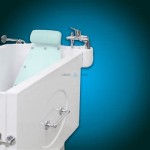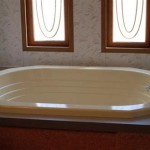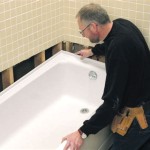Grohe Bathtub Faucet Cartridge Replacement: A Comprehensive Guide
The Grohe brand is synonymous with quality and innovation in the realm of plumbing fixtures. Grohe bathtub faucets, renowned for their durability and sleek design, often provide years of reliable service. However, like any mechanical component exposed to constant water flow and mineral buildup, the internal cartridge of a Grohe bathtub faucet can eventually wear out, leading to leaks, inconsistent water temperature, or difficulty controlling water flow. Replacing the cartridge is a common repair procedure that can restore the faucet's functionality without the expense of replacing the entire unit. This article provides a detailed guide to replacing a Grohe bathtub faucet cartridge, covering essential tools, safety precautions, step-by-step instructions, and troubleshooting tips.
Before embarking on the replacement process, it is crucial to correctly identify the type of cartridge used in the specific Grohe bathtub faucet. Grohe manufactures a wide variety of faucet models, each potentially utilizing a different cartridge design. Incorrect cartridge identification can lead to purchasing the wrong replacement part, rendering the repair process ineffective. The faucet's model number is usually printed on the faucet body itself, often near the base or underneath the handle. Consulting the Grohe website or contacting a Grohe authorized dealer with the model number will allow for accurate cartridge identification.
Key Point 1: Preparation and Safety Precautions
Prior to beginning any plumbing repair, safety should be the paramount concern. The first and most important step is to shut off the water supply to the bathtub faucet. Typically, this can be achieved by turning off the shut-off valves located beneath the sink, within the bathroom, or in the main water supply line to the house. If individual shut-off valves are not available, shutting off the main water supply is necessary. After turning off the water, open the bathtub faucet to relieve any residual pressure within the pipes. This prevents unexpected bursts of water during the disassembly process.
Gathering the necessary tools is another essential preparatory step. The tools required may vary slightly depending on the specific Grohe faucet model, but the following are commonly needed: a flathead screwdriver, a Phillips head screwdriver, an adjustable wrench, pliers, a set of Allen wrenches (hex keys), possibly a specialized cartridge removal tool (depending on the cartridge type), a clean cloth or rag, and potentially a lubricant such as plumber's grease. Having all tools readily available will streamline the repair process and minimize delays. It is also recommended to have a small container or bag on hand to store any small screws or parts to prevent them from being lost.
Protecting the finish of the faucet is also important. Using masking tape around vulnerable areas, such as the faucet handle and escutcheon, can prevent scratches or damage during disassembly. A soft cloth placed around the faucet during wrenching operations can further safeguard the finish from accidental marks.
Key Point 2: Step-by-Step Cartridge Replacement
The following steps outline the general process for replacing a Grohe bathtub faucet cartridge. While slight variations may occur depending on the specific faucet model, the core principles remain consistent.
1.
Handle Removal:
The initial step involves removing the faucet handle. This usually entails loosening a set screw located on the side or underneath the handle. Use an Allen wrench (hex key) of the appropriate size to loosen the set screw. Once loosened, the handle should slide off. Some Grohe faucets may have a decorative cap covering the set screw. This cap can be carefully pried off with a small flathead screwdriver.2.
Escutcheon Removal:
The escutcheon is the decorative plate that covers the valve body. It is typically held in place by screws or a threaded connection. Look for screws around the perimeter of the escutcheon and remove them with a Phillips head screwdriver. If there are no visible screws, the escutcheon may be threaded onto the valve body. In this case, carefully unscrew the escutcheon by hand or with the aid of an adjustable wrench, ensuring that the faucet's finish is protected by a cloth.3.
Cartridge Retaining Clip Removal:
Once the escutcheon is removed, the cartridge retaining clip will be visible. This clip secures the cartridge in place within the valve body. The clip may be a C-shaped clip or a more complex retaining mechanism. Use a small flathead screwdriver or pliers to carefully remove the retaining clip. Note the orientation of the clip before removal, as it must be reinstalled in the same manner.4.
Cartridge Removal:
With the retaining clip removed, the cartridge can now be extracted from the valve body. In some cases, the cartridge may slide out easily. However, if the cartridge is stuck due to mineral buildup or corrosion, a specialized cartridge puller tool may be necessary. Avoid using excessive force, as this could damage the valve body or the cartridge itself. Gentle rocking or twisting motions, combined with the cartridge puller, can help to dislodge the cartridge. If a cartridge puller is unavailable, carefully use pliers to grip the cartridge body (avoiding the plastic components) and gently pull it out. Plumber's grease applied around the cartridge housing might also aid in removal.5.
Cleaning the Valve Body:
After removing the old cartridge, thoroughly clean the inside of the valve body. Use a clean cloth or rag to remove any dirt, debris, or mineral deposits. Inspect the valve body for any signs of damage or corrosion. If necessary, use a mild descaling solution to remove stubborn mineral buildup. Rinse the valve body thoroughly with clean water before proceeding.6.
Installing the New Cartridge:
Before installing the new cartridge, lubricate it with plumber's grease. This will facilitate insertion and ensure smooth operation. Carefully align the new cartridge with the valve body and gently push it into place. Ensure that the cartridge is fully seated and properly aligned.7.
Reinstalling the Retaining Clip:
Reinstall the cartridge retaining clip in the same orientation as it was originally. Ensure that the clip is securely in place and that it properly locks the cartridge into the valve body.8.
Reinstalling the Escutcheon and Handle:
Reinstall the escutcheon and handle in reverse order of their removal. Tighten the screws or thread the escutcheon securely onto the valve body. Reattach the handle and tighten the set screw.9.
Testing the Faucet:
After reassembling the faucet, turn on the water supply slowly and check for leaks around the faucet body, handle, and escutcheon. Operate the faucet through its full range of motion to ensure smooth operation and proper temperature control. If any leaks are detected, immediately shut off the water supply and re-examine the connections. Ensure that all components are properly seated and tightened.Key Point 3: Troubleshooting Common Issues
Despite following the steps outlined above, certain issues may arise during the cartridge replacement process. These issues can often be resolved with careful troubleshooting.
Difficulty Removing the Old Cartridge:
If the old cartridge is stuck and difficult to remove, mineral buildup or corrosion is likely the culprit. Try applying a penetrating oil or descaling solution around the cartridge housing and allow it to sit for several minutes. Then, attempt to remove the cartridge using a cartridge puller or pliers, applying gentle but firm pressure. Avoid using excessive force, as this could damage the valve body.Leaks After Cartridge Replacement:
Leaks after cartridge replacement can indicate several potential problems. Ensure that the cartridge is fully seated and properly aligned within the valve body. Check the retaining clip to ensure that it is securely in place. Examine the O-rings on the cartridge for any signs of damage or wear. If the O-rings are damaged, they may need to be replaced. Also, verify that the escutcheon and handle are properly tightened.Inconsistent Water Temperature or Flow:
If the water temperature is inconsistent or the water flow is restricted after cartridge replacement, the cartridge may not be properly aligned or calibrated. Refer to the manufacturer's instructions for the specific cartridge model to ensure proper installation and calibration. In some cases, the cartridge may need to be adjusted to achieve the desired water temperature and flow.Damage to the Valve Body:
In rare cases, the valve body may be damaged during the cartridge removal or installation process. If the valve body is cracked or corroded, it may need to be replaced. This is a more complex repair that may require professional assistance.Replacing a Grohe bathtub faucet cartridge is a manageable task for homeowners with basic plumbing skills and the appropriate tools. By following the steps outlined in this guide and taking necessary safety precautions, individuals can restore their faucet's functionality and avoid the expense of replacing the entire unit. However, if encountering significant difficulties or uncertainties, consulting a qualified plumber is always recommended.

Grohe 48 243 Replacement Faucet Cartridge Com

Grohe Universal Widespread Cartridge For Right Handle Saniterica

Grohe Shower Valve Handles Keep Falling Off Lets Get To Fixin

Grohe Mixer Valve 34963 000 Shower Spares And Parts 34963000 National

Grohe Replacement Pressure Balance Tub Shower Faucet Cartridge 47995 K35b Com Cartridges Inc 778 688 6448

Grohe Tallinn Single Handle 1 Spray Bathtub And Shower Faucet In Brushed Nickel Valve Included 35097en0 The Home Depot

Grohe Shower Valves Frank Webb Home

Grohe 46374000 N A Replacement Ceramic Cartridge Only Faucetdirect Com

Grohe Replacement Pressure Balance Tub Shower Faucet Cartridge 47995 K35b Com Cartridges Inc 778 688 6448

Parts For Grohe Seabury Series Vintage Designer Bath Fixtures








